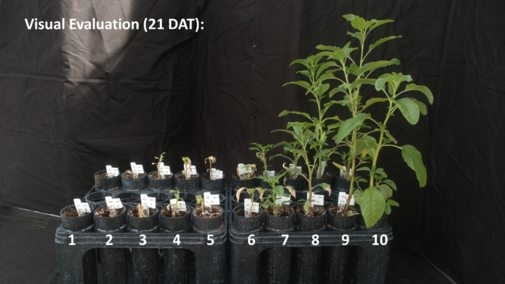Rodrigo Werle, Assistant Professor and Extension Weed Scientist at the University of Wisconsin-Madison, formerly at the University of Nebraska-Lincoln
Mithila Jugulam, Associate Professor and Weed Physiologist, Kansas State University
Greg Kruger, Associate Professor, Weed Science and Application Technology Specialist, University of Nebraska-Lincoln
Amaranatha Vennapusa, Postdoctoral Research Associate, Kansas State University
Felipe Faleco, former visiting Undergraduate Student, University of Nebraska-Lincoln
Bruno Vieira, Graduate Student, University of Nebraska-Lincoln
Spencer Samuelson, former Graduate Student, University of Nebraska-Lincoln
Waterhemp is a troublesome summer annual broadleaf weed species that has evolved resistance to glyphosate and other herbicide sites of action (SOA) in Nebraska, including to groups 2 (i.e., Classic, Pursuit, FirstRate), 4 (i.e., 2,4-D), 5 (i.e., atrazine) and 27 (e.g., Callisto, Laudis). The overall objectives of this study were to
- evaluate the efficacy of PRE applied atrazine, metribuzin and sulfentrazone to control Nebraska waterhemp populations;
- evaluate the efficacy of POST applied atrazine to control Nebraska waterhemp populations; and
- determine the mechanism of atrazine resistance in Nebraska waterhemp populations.
This research was recently published in the Weed Science Journal.
Objective 1. Screening of Nebraska Waterhemp with PRE Applied Atrazine, Metribuzin, and Sulfentrazone

Figure 1. Distribution of waterhemp populations collected in Nebraska in 2014 and screened with soil-applied PSII (atrazine and metribuzin) and PPO (sulfentrazone) inhibitor herbicides. Seeds from a total of 109 populations from 32 counties were collected by Greg Kruger’s lab. These populations were also screened for resistance to glyphosate by UNL Graduate Student Bruno Vieira. (See Distribution of glyphosate‐resistant Amaranthus spp. in Nebraska in Pest Management Science.)
The first objective was to evaluate the response of 109 common waterhemp populations collected in Nebraska (Figure 1) to PRE applied PSII and PPO herbicides sprayed at label rates. Herbicide treatment consisted of atrazine (Atrazine 4L SC, 2.4 pts/acre), metribuzin (Sencor, 0.67 lbs/acre) and sulfentrazone (Spartan, 8 fl oz/acre). The experiment was conducted in 3.5-inch square plastic pots filled with regular soil (Loam soil, pH = 6.4, and 1.7% OM). A volume of 0.04 ml of seeds was planted per pot (average of 90 seeds).
The herbicides were applied immediately after planting using a spray chamber calibrated to deliver 10 gallons per acre (GPA) using AIXR110015 nozzles. After being sprayed, pots were placed in a greenhouse with controlled temperature and were watered daily. At 30 days after treatment (DAT), the total number of established plants per pot was recorded. The percent reduction in total plant density was calculated for each herbicide treatment. In an additional study, 106 waterhemp populations were screened with soil-applied atrazine at 3X the label rate (Atrazine 4L SC, 7.2 pts/acre), using the experimental procedures described above. Populations with less than 50% reduction in plant stand were considered resistant to the respective herbicide treatment and rate.
Results
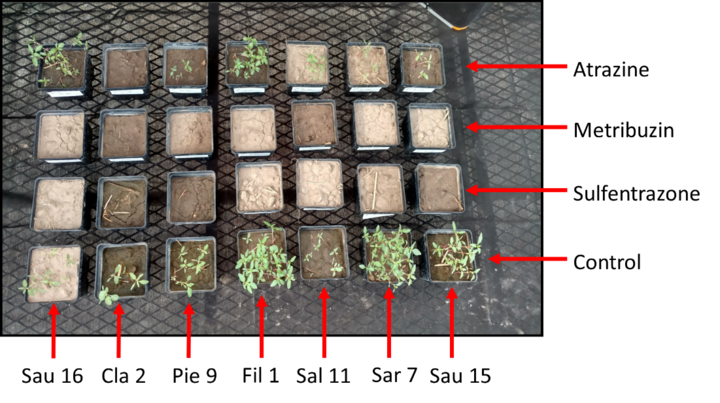
- Metribuzin and sulfentrazone controlled all populations tested (100% density reduction; Figure 2). Thus, these two commonly used herbicides for PRE weed control in soybeans were effective on all waterhemp populations tested in this research.
- Atrazine PRE applied at 1X and 3X did not effectively control 39% (43 out of 109 populations) and 40% (42 out of 106 populations) of all populations screened (Table 1). Therefore, resistance to PRE applied atrazine is prevalent in Nebraska waterhemp populations.
- Even though atrazine and metribuzin belong to the same herbicide SOA, cross-resistance (mechanism that provides a weed population the ability to withstand herbicides from different chemical families within the same SOA) was not confirmed. That’s good news!
Objective 2. Screening of Waterhemp with POST Applied Atrazine.
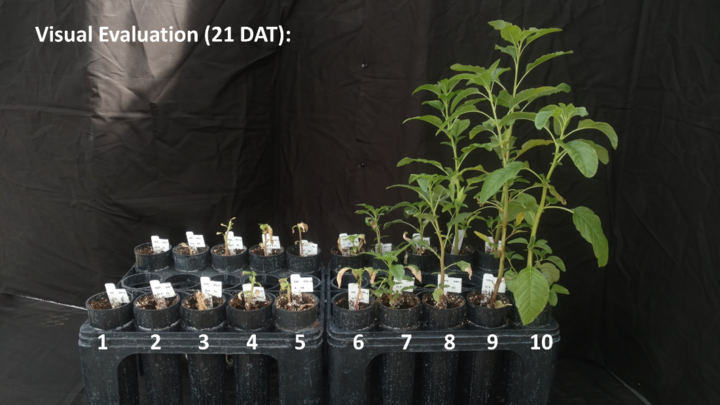
The second objective of the study was to evaluate the response of 85 waterhemp populations to atrazine applied POST waterhemp emergence at 1X (Atrazine 4L SC, 2.4 pts/acre) and 3X (Atrazine 4L SC, 7.2 pts/acre) the label rate. Waterhemp plants (total of 12 plants per population were screened for each rate) were grown in cones (2.5-inch in diameter and 10-inch in depth), maintained in a greenhouse with a controlled environment, and watered daily.
Treatments were applied when waterhemp plants reached 2.5 to 3.5 inches in height using the aforementioned sprayer equipment and calibration settings. At 21 DAT, visual evaluation (VE) of plant growth was taken on a scale of 1 to 10, with one being dead and ten being completely healthy (Figure 3). For each population and treatment, the percent of treated plants with VE ≥ 7 was calculated. In this experiment, waterhemp populations were considered resistant to each atrazine rate (1X or 3X) if more than 50% of the treated plants had a VE ≥ 7.
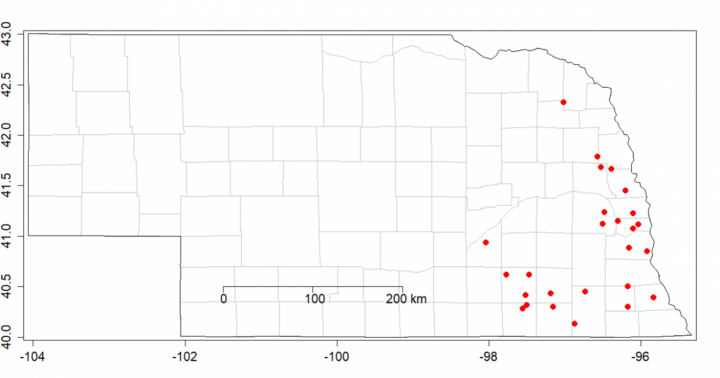
Results
- Atrazine at 1X and 3X did not effectively control 73% (62 out of 85 populations) and 49% (42 out of 85 populations) of all populations screened (Table 1). Therefore, resistance to POST applied atrazine is prevalent in Nebraska waterhemp populations.
- In this study 31% of 85 populations were confirmed resistant to both PRE and POST at 3X label rate (Figure 4). Atrazine was more effective (e.g., fewer populations classified as resistant) when PRE- versus POST-applied. Thus when using atrazine in corn, farmers are more likely to obtain better levels of waterhemp control if the herbicide is used PRE in combination with other effective SOA.
| Treatment | Populations Screened a | Resistant Populations | % Resistant Populations b |
|---|---|---|---|
| Atrazine PRE 1X | 109 | 43 | 39% |
| Atrazine PRE 3X | 106 | 42 | 40% |
| Atrazine POST 1X | 85 | 62 | 73% |
| Atrazine POST 3X | 85 | 42 | 49% |
| a Not all 109 populations were evaluated for all treatments because of seed availability. | |||
| b Populations with less than 50% reduction in plant stand and populations with more than 50% of treated plants with visual evaluation ≥ 7 (healthy plants capable of reproducing) were classified as resistant to the respective PRE and POST atrazine rate, respectively. | |||
Objective 3. Investigation of Molecular Mechanism of Nebraska Waterhemp Resistance to Atrazine
Target-site mutation. The Ser-264-Gly substitution is known to confer resistance to atrazine in the majority of weed species. The chloroplastic psbA gene, coding for D1 protein (target site of atrazine), was sequenced using DNA extracted from 85 plants representing 27 populations of waterhemp from Nebraska. The comparison of the nucleotide sequence of the psbA gene between the atrazine-resistant waterhemp plants from Nebraska and a known waterhemp atrazine susceptible population from Missouri did not reveal any mutation resulting in a Ser-264-Gly substitution (data not shown). This indicates that the common target-site mutation is not the common mechanism conferring resistance to atrazine in Nebraska waterhemp populations.
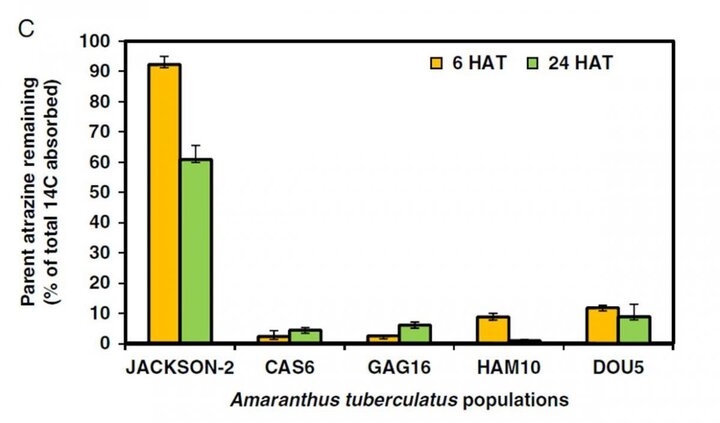
Metabolism of atrazine. Twenty-four plants selected randomly from four atrazine-resistant populations from Nebraska were used to determine the metabolism of atrazine via GST conjugation. Rapid metabolism of atrazine via GST conjugation has been reported to confer resistance in waterhemp in Illinois. Our results also confirm rapid detoxification of atrazine via GST-mediated conjugation in the evaluated waterhemp populations from Nebraska (Figure 5). The outcome of this study clearly demonstrate the predominance of metabolism-based resistance to atrazine in common waterhemp from Nebraska, which may predispose this species to evolve resistance to other herbicide families. This is a concern and a new frontier of studies within the Weed Science Discipline.
Take-Home Message
- PRE-emergence soybean herbicides metribuzin and sulfentrazone are effective to manage common waterhemp in Nebraska.
- The control of most Nebraska populations was not satisfactory when atrazine was solely used as PRE or POST; however, PRE application of atrazine was more effective than POST application.
- No cross-resistance to atrazine and metribuzin was observed in this study.
- Rapid metabolism of atrazine via GST conjugation conferred resistance in the populations tested. The metabolism-based resistance may trigger the evolution of cross-resistance to other herbicides, which may represent a challenge to effectively control common waterhemp in Nebraska and beyond.
- Integrated weed management strategies and diversified herbicide programs with selective soil-applied herbicides can assist growers to achieve better common waterhemp control and ameliorate the issues with herbicide resistance.
Acknowledgments
The authors would like to thank Liberty Butts and Jared Daily for their assistance with the greenhouse screenings. Numerous students and technicians in the University of Nebraska-Lincoln Pesticide Application Technology Laboratory were invaluable in collecting and processing the weed seed samples from across Nebraska. Thanks to the Weed Physiology Lab at Kansas State University for conducting the molecular research.
